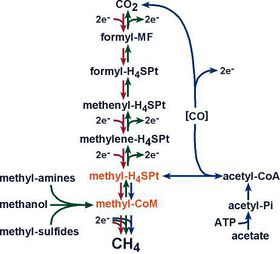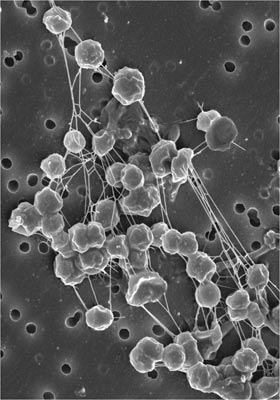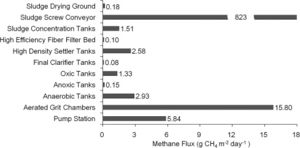The Role of Methanogens in Waste Water Treatment: Difference between revisions
Mooradianm (talk | contribs) |
Mooradianm (talk | contribs) |
||
| Line 2: | Line 2: | ||
by Melissa Mooradian | by Melissa Mooradian | ||
<br>[[File: Methanogen.jpeg |thumb|300px|right|Filamentous methanogen. Obtained from Maryland Astrobiology Consortium, NASA, and STScI]]<br> | <br>[[File: Methanogen.jpeg |thumb|300px|right|Filamentous methanogen. Obtained from Maryland Astrobiology Consortium, NASA, and STScI]]<br> | ||
As one of the most diverse groups of Archaea known to date, the Methanogens represent the euryarchaeota order which gains energy via methane production. The methanogens utilize the metabolic process of methanogenesis, which is the methane production pathway that converts carbon dioxide and other bacterial waste products into methane. Methanogens have become the focus of recent literature due to their large contribution to global methane emissions as well as their role in wastewater treatment. Methane is a potent greenhouse gas that has a global warming potential of 25 in a 100 year time frame and is estimated to account for 20% of the total radiative forcing from all greenhouse gases (Wang et al., 2011). The recent increase in methane emissions, from natural systems such as wetlands as well as landfills and agricultural cattle, has made the understanding of methanogens crucial to reducing the effects of climate change. Although methane emissions have negative environmental impacts, the use of methanogens can be crucial in reducing wastewater and the pollution of water systems across the world. Methanogens help break down organic material that would otherwise pollute water sources and lead to environmental degradation. The construction of wetland systems in developing countries has been adopted as a low cost and highly effective method of reducing nutrient concentrations and degrading organic compounds in agricultural as well as urban wastewaters (Johansson, et al., 2004). The balance of these two impacts is vitally important for the future. | |||
==Methanogens== | ==Methanogens== | ||
Revision as of 01:22, 23 April 2014
Introduction
by Melissa Mooradian
As one of the most diverse groups of Archaea known to date, the Methanogens represent the euryarchaeota order which gains energy via methane production. The methanogens utilize the metabolic process of methanogenesis, which is the methane production pathway that converts carbon dioxide and other bacterial waste products into methane. Methanogens have become the focus of recent literature due to their large contribution to global methane emissions as well as their role in wastewater treatment. Methane is a potent greenhouse gas that has a global warming potential of 25 in a 100 year time frame and is estimated to account for 20% of the total radiative forcing from all greenhouse gases (Wang et al., 2011). The recent increase in methane emissions, from natural systems such as wetlands as well as landfills and agricultural cattle, has made the understanding of methanogens crucial to reducing the effects of climate change. Although methane emissions have negative environmental impacts, the use of methanogens can be crucial in reducing wastewater and the pollution of water systems across the world. Methanogens help break down organic material that would otherwise pollute water sources and lead to environmental degradation. The construction of wetland systems in developing countries has been adopted as a low cost and highly effective method of reducing nutrient concentrations and degrading organic compounds in agricultural as well as urban wastewaters (Johansson, et al., 2004). The balance of these two impacts is vitally important for the future.
Methanogens

Methanogenesis

Uses in Wastewater Treatment
Possible Environmental Impacts
Include some current research in each topic, with at least one figure showing data.
Conclusion
Overall paper length should be 3,000 words, with at least 3 figures.
References
[8][Slonczewski, J.L., and Foster, J.W. "Microbiology: An Evolving Science". W.W. Norton and Company. 2014. Third Edition.]
Edited by student of Joan Slonczewski for BIOL 238 Microbiology, 2009, Kenyon College.



